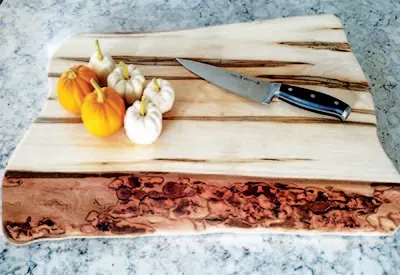There is nothing more beautiful than a piece of live edge wood. The random lines of exposed wood grain and the natural edge, along with the brilliant colors of the wood make it seem like it could nearly come back to life.
Live edge wood is about as close as you can get to using an actual tree for a project. To make them, a log is simply slabbed “as-is” to reveal the grain of the wood, keeping all or most of the bark and the curved edge of the tree in place.
The look has become extremely popular in the last few years. Live edge wood slabs can be used for shelves, coffee tables, bar tops, cutting boards and more. In fact, the only limitation to using live edge wood is your own imagination!
The beauty of working with live edge for the DIY’er is that the tree did almost all of the work for you. There are no gluing of joints, or hours of cutting and planing the wood. Instead, the slab of wood determines much of your final work. The real effort comes in finding creative ways to use it.
I was first introduced to live edge wood at Almendingers, a local sawmill near us in Johnstown, Ohio. I had been going there for years to purchase most of our rough-sawn wood for projects. I was looking at the time for a large piece of wood for our very first wine rack, and the owner started showing me all kinds of beautiful live edge slabs of cherry, pine, maple, oak and more. I instantly fell in love! Ever since, I am always on the lookout for what I can make next from these beautiful wood slabs.
Here is a look at two of our favorite live edge wood creations over the past few years.
Ambrosia Maple Cutting Board
We had been looking for quite some time for a larger cutting board for our big center island. The minute I saw the slab of Ambrosia maple at our local sawmill, I knew the looking was over! Maple is an excellent wood choice for a cutting board. It’s tighter grain and harder surface are a safe and strong surface when sealed.
As for Ambrosia maple, it’s actually not a type of maple tree. It is instead a maple tree that has been infected by the ambrosia beetle.
The beetles leave behind a gorgeous striped and spalted pattern of discolored wood. When finished and sealed, it is simply stunning.
The live edge slab we found measured nearly 20″ wide x 8′ long. The width made it perfect for creating an over-sized piece. For our board, we began by cutting a 33″ piece from the slab with a orbital jig saw. We traced a few subtle curves in the cut lines to create a random pattern before cutting.
Next we carefully removed the bark with a chisel to reveal the natural wood edge. When working with live edge wood, it is amazing how a good set of chisels can go a long way! (4 piece DeWalt Wood Chisel Set) We then sanded smooth, and cleaned the surface with mineral spirits. When the live edge cutting board dried, we sealed with four coats of bees-wax and mineral oil, added a few adhesive pads to the bottom, and our live edge ambrosia maple cutting board was complete!
Live Edge Wine Rack and Cabinet
By far, my favorite live edge wood piece is our homemade wine rack cabinet. We built the wine rack from left over shiplap when we built the house. (See : Wine Rack Project)
When it came time for a top – we found the perfect piece of 3″ thick cherry at Almendingers to cover it. The hardest part was figuring out how to attach it. We accomplished that by drilling a few pilot holes in top strip of the rack and securing up into the slab with 3″ screws.
Our next project – a live edge slab coffee table! Hopefully, we can showcase that in the next few months on the blog.
Here’s to the beauty of working with live-edge wood on your next project! Jim and Mary.
To receive our 3 Home, Garden, Recipe and Simple Life articles each week, sign up for our free email list. You can also follow us on Facebook, Twitter, Pinterest, or Instagram. This article may contain affiliate links.



